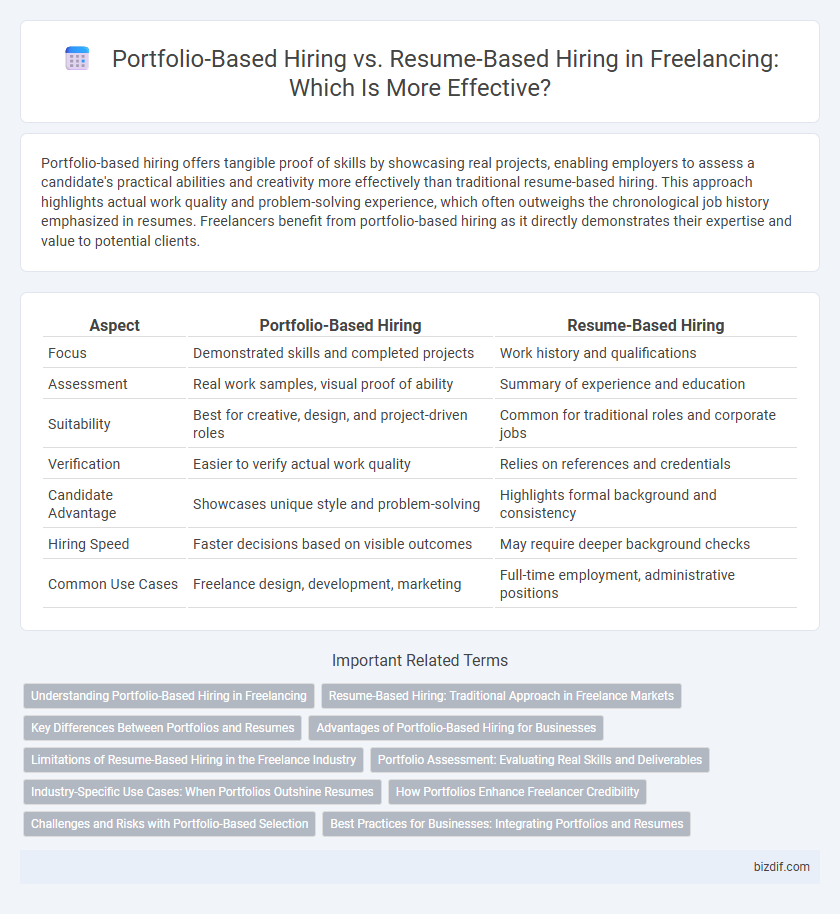Portfolio-based hiring offers tangible proof of skills by showcasing real projects, enabling employers to assess a candidate's practical abilities and creativity more effectively than traditional resume-based hiring. This approach highlights actual work quality and problem-solving experience, which often outweighs the chronological job history emphasized in resumes. Freelancers benefit from portfolio-based hiring as it directly demonstrates their expertise and value to potential clients.
Table of Comparison
| Aspect | Portfolio-Based Hiring | Resume-Based Hiring |
|---|---|---|
| Focus | Demonstrated skills and completed projects | Work history and qualifications |
| Assessment | Real work samples, visual proof of ability | Summary of experience and education |
| Suitability | Best for creative, design, and project-driven roles | Common for traditional roles and corporate jobs |
| Verification | Easier to verify actual work quality | Relies on references and credentials |
| Candidate Advantage | Showcases unique style and problem-solving | Highlights formal background and consistency |
| Hiring Speed | Faster decisions based on visible outcomes | May require deeper background checks |
| Common Use Cases | Freelance design, development, marketing | Full-time employment, administrative positions |
Understanding Portfolio-Based Hiring in Freelancing
Portfolio-based hiring in freelancing emphasizes evaluating a candidate's actual work samples, demonstrating practical skills and expertise relevant to project requirements. This approach allows clients to assess quality, creativity, and problem-solving abilities through tangible deliverables rather than relying solely on resume credentials or formal qualifications. Freelancers benefit by showcasing real-world results and specialized talents, increasing trust and alignment with client expectations.
Resume-Based Hiring: Traditional Approach in Freelance Markets
Resume-based hiring in freelance markets relies on a traditional approach where clients evaluate candidates primarily through documented work history, education, and skill certifications. This method emphasizes verifying qualifications and experience but often overlooks real-time project performance and creativity showcased in portfolios. Consequently, resume-based hiring may limit freelancers who excel in practical skills and innovative solutions that are better demonstrated through project samples.
Key Differences Between Portfolios and Resumes
Portfolios showcase practical examples of a freelancer's work, demonstrating skills, creativity, and results through tangible projects, while resumes provide a concise summary of professional experience, education, and skills in a structured format. Portfolios allow clients to assess the quality and style of work, making them essential for creative fields such as design, writing, and software development, whereas resumes are more suited for roles with standardized qualifications and job history. The interactive and visual nature of portfolios offers a dynamic evaluation, contrasting with the static, text-based overview presented in resumes.
Advantages of Portfolio-Based Hiring for Businesses
Portfolio-based hiring enables businesses to evaluate a candidate's real-world skills and project outcomes, providing tangible evidence of their capabilities beyond the standard resume claims. This approach reduces hiring risks by showcasing practical experience, work quality, and problem-solving abilities, which aligns more closely with the job requirements. Companies benefit from accelerated decision-making and improved talent fit, driving higher productivity and reducing turnover rates in freelancing projects.
Limitations of Resume-Based Hiring in the Freelance Industry
Resume-based hiring often fails to capture the full scope of a freelancer's skills, versatility, and project outcomes, leading to missed opportunities for both clients and professionals. This method prioritizes formal qualifications and work history over demonstrated capabilities, which are better showcased through a detailed portfolio featuring actual deliverables and client feedback. In the freelance industry, reliance on resumes can result in mismatched expectations, as it lacks the dynamic evidence of practical experience essential for evaluating freelance talent accurately.
Portfolio Assessment: Evaluating Real Skills and Deliverables
Portfolio-based hiring emphasizes evaluating freelancers through tangible work samples and demonstrable skills, providing a clearer insight into their actual capabilities and job fit. Unlike resume-based hiring, which relies on self-reported qualifications and roles, portfolio assessment showcases real deliverables, highlighting creativity, technical expertise, and problem-solving abilities. This method reduces hiring risks by allowing clients to verify the quality and relevance of work before engagement.
Industry-Specific Use Cases: When Portfolios Outshine Resumes
In creative industries such as graphic design, software development, and content creation, portfolio-based hiring provides tangible proof of skills and past projects, offering employers direct insight into a candidate's capabilities and style. Unlike resumes that list qualifications and experience, portfolios showcase real-world applications of expertise, making them indispensable for roles requiring demonstrable creativity and technical proficiency. Companies in advertising, web development, and multimedia production prioritize portfolios to assess innovation, problem-solving, and execution quality before making hiring decisions.
How Portfolios Enhance Freelancer Credibility
Portfolios provide tangible evidence of a freelancer's skills and past work, which significantly enhances credibility by showcasing real project outcomes and client satisfaction. Unlike resumes that list qualifications and experiences, portfolios offer visual and detailed proof that helps clients assess the quality and relevance of a freelancer's expertise. This direct demonstration of capability builds trust and increases the likelihood of securing freelance projects.
Challenges and Risks with Portfolio-Based Selection
Portfolio-based hiring presents challenges such as subjective evaluation and inconsistent quality across projects, making it difficult to standardize assessments. Risks include potential misrepresentation of skills due to curated work samples and the inability to fully gauge soft skills or teamwork capabilities. This hiring method may also overlook candidates with strong potential but limited portfolio exposure, impacting diversity and inclusivity in talent acquisition.
Best Practices for Businesses: Integrating Portfolios and Resumes
Integrating portfolios with resumes provides businesses a comprehensive view of a freelancer's skills and proven work, enhancing hiring accuracy and project fit. Best practices include evaluating portfolios for relevant projects alongside resumes to verify experience and capabilities, fostering a more holistic assessment. Leveraging digital platforms that support portfolio showcase and resume analysis streamlines the hiring process and attracts high-quality freelance talent.
Portfolio-based hiring vs Resume-based hiring Infographic

 bizdif.com
bizdif.com